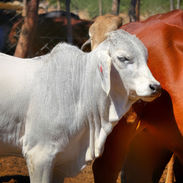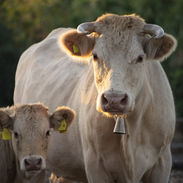Raising Animals for Beginners
Cattle Breeds

Choosing the right or best possible breed for your custom needs is paramount for a good cattle business.
When choosing a breed consider the following:
1. What breeds are available and affordable in your region or locality. First, search for options by taking information from mediums as agriculture marketing resources, agriculture advisors, state agriculture departments, through own connections and experience, classifieds in news/marketing publications, contacting breeding farms, internet, etc.
2. Dairy cows: Consider the level of milk producing ability of all the options of breeds that you have. While some breeds are able to produce a significant amount per day, the others might not reach the similar amount. So, lets explore few popular dairy cow breeds around the globe.
Holstein Dairy Cows

Holstein Cattle | NANURA Agri by Dona Nalaka Daundaratne. BSc, MAg and Jemegwa Malàbe
These cows are milk producing super machines that can produce around 25-30Ls of milk per day. They were originated in Northern Germany and considered as the most popular dairy cow breed around the world.
Jersey Dairy Cows



Jersey cattle | NANURA Agri by Dona Nalaka Daundaratne. BSc, MAg and Jemegwa Malàbe
Jerseys are also recognized breed of dairy cows that yields a daily milk production of approximately 20-22L. They are originally from Great Britain and spread around the continents. If you are planning to develop a cheese or a butter production, these animals are the best option due to high concentrations of lipids in their milk.
Ayrshire Dairy Cows

Ayrshire cattle | NANURA Agri by Dona Nalaka Daundaratne. BSc, MAg and Jemegwa Malàbe
These Scotland-originated creatures are also a great choice for a dairy business as they are known to yield around 25L of milk per day. These cows are also distributed almost around the entire world in the dairy production industry
Shorthorn Dairy Cows

Shorthorn cattle | NANURA Agri by Dona Nalaka Daundaratne. BSc, MAg and Jemegwa Malàbe
Shorthorns are a popular breed that is considered good for both dairy production and meat production. They have a good feed/food conversion ratio (FCR) which means that a high output of milk/meat per amount of food consumed during a period. Better FCR equal better profits. So, this cattle feed is good for either of the goals or even if you are planning to raise cattle for both meat and milk.
Sindhi (Malir) Dairy Cows

Malir cattle | NANURA Agri by Dona Nalaka Daundaratne. BSc, MAg and Jemegwa Malàbe
Sindhi cows are a popular breed in dairy farming, dominantly, around Asia (India, Pakistan, Ceylon) and Africa. Originally, they come from Pakistan and today being distributed widely around the world. Sindhi produces around 10L in average and highly adaptable to warmer and tougher environments. Due to this reason, they are much popular and suitable for regions with tropical environment.
Gyr Cows

Gyr cattle | NANURA Agri by Dona Nalaka Daundaratne. BSc, MAg and Jemegwa Malàbe
Originated in India, Gry can produce around 15L of milk per day. Currently, like Sindhi, this is a breed that is distributed around the world. Especially, as cross-bred variety, in the Brazilian dairy industry.
3. Meat Productivity
Let’s look at few commonly raised breeds that are good options for your beef business or may be both.
Simmental Cattle Breed

Simmental cattle | NANURA Agri by Dona Nalaka Daundaratne. BSc, MAg and Jemegwa Malàbe
While originated in Switzerland, they are very popular around the world for both dairy production and high beef production. This ability to produce a significant amount of milk allows to the calves to grow fast and turn to bigger animals yielding higher beef output. On the other hand, they can be primarily used as dairy cows as well. In addition, this breed is known to be very adaptable to most of the environmental conditions which enable us to raise them around the world. Their being raised in Africa, America, Europe, Australia, and in Asian countries as India, Ceylon, and Nepal. So, these all-purpose animals are an ideal option is easily available in your region.
Highland Cattle Breed

Highland cattle | NANURA Agri by Dona Nalaka Daundaratne. BSc, MAg and Jemegwa Malàbe
If you are living in a much colder climate in areas as far North, Highlands are one of the top preferred breeds to raise. Their long furry coat and subcutaneous fat protects them from extreme cold temperatures. Further, Highlands’ yield increased amount and quality of lean meat making them popular among consumers. However, they can be raised in dry and warmer climates due to their satisfactory level of adaptability. Further, this breed carries a low maintenance cost, and they grow faster and profitable.
Angus Beef Cattle

Angus cattle | NANURA Agri by Dona Nalaka Daundaratne. BSc, MAg and Jemegwa Malàbe
Angus is a breed popular around the world for its quality meat and higher FCR. There are sub-groups of Angus raised in different regions. For example, Aberdeen Angus being the original and native to Scotland are commonly found in Europe, in North America, including US and Canada you find Black Angus and Red Angus. The German cross-bred Angus is another commonly raised kind in Europe. Anyhow, Angus breed is spread around the world in the beef farming industry, and it can be a good choice for your business depending on factors like buying cost and availability in your locality.
Truly, there are numerous breeds of cattle in the world market. It is always important identify what are the key aspects that determines the best choice for the individual business. As we have pinpointed, do your research well. Get information from any reliable Agriculture information source your local community or in your country to get relevant knowledge specific to your area. For example, contact the state Agriculture department or a branch. There can be organisations to assist farmers through universities. If non-easily accessible, speak to a Veterinary doctor or officer in reach. They are good source of information on deciding which breed to choose. Especially, to know about specific health related advantages and risks associated to some breeds. For example, Highlands tends to have much lower risk of health related the eye complications as infections and cancer. Then, they can tell you how the breeding and pregnancy of available breeds are favorable to manage. Not only that, but your Vet might also have lot of contacts that will be valuable for you to get more education as well as support and resources. Jemegwa Malabe and Dona Nalaka Daundaratne always stresses the importance of “knowing what your do and taking informed decisions” crucial to become a successful farmer as with any other business. So, even if you are from a traditional farming family and planning to start your own business reach out the world to see what new recommendations and currency best practice guidelines are.
























